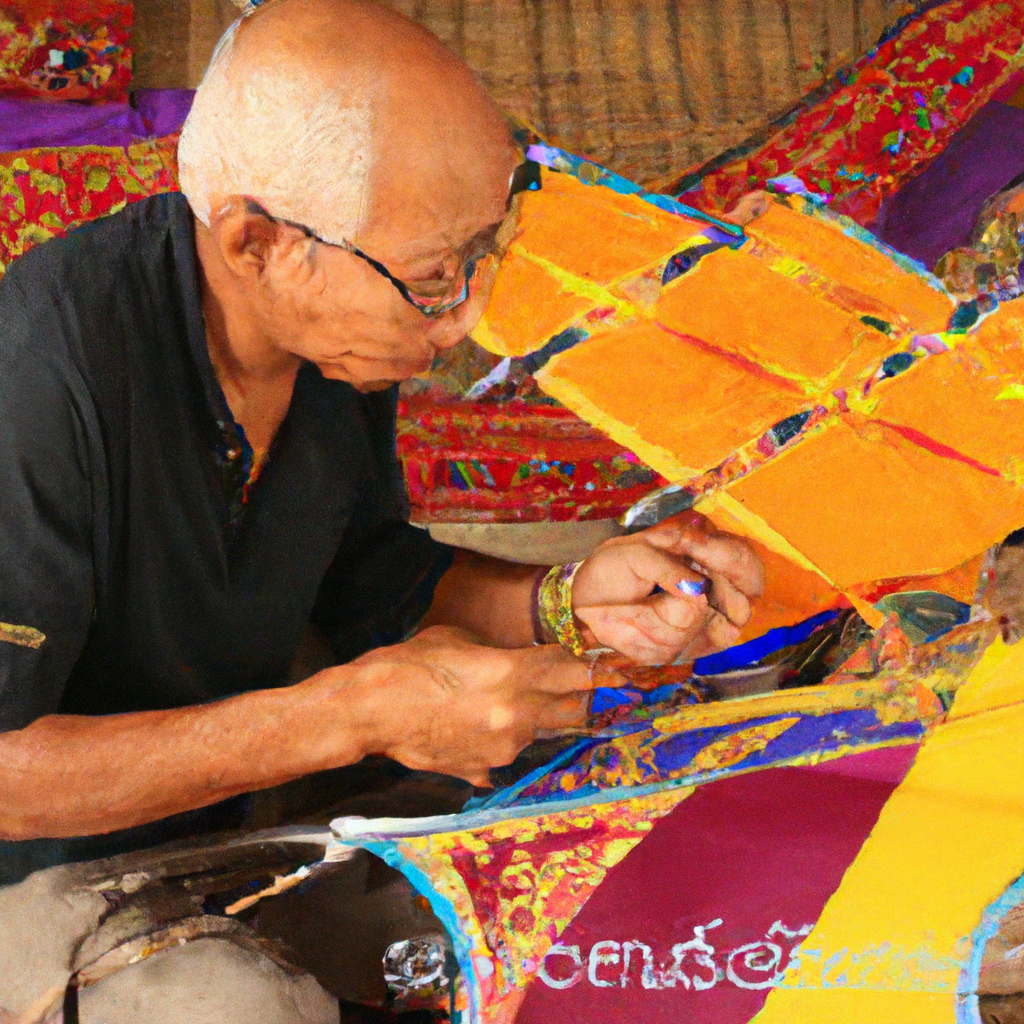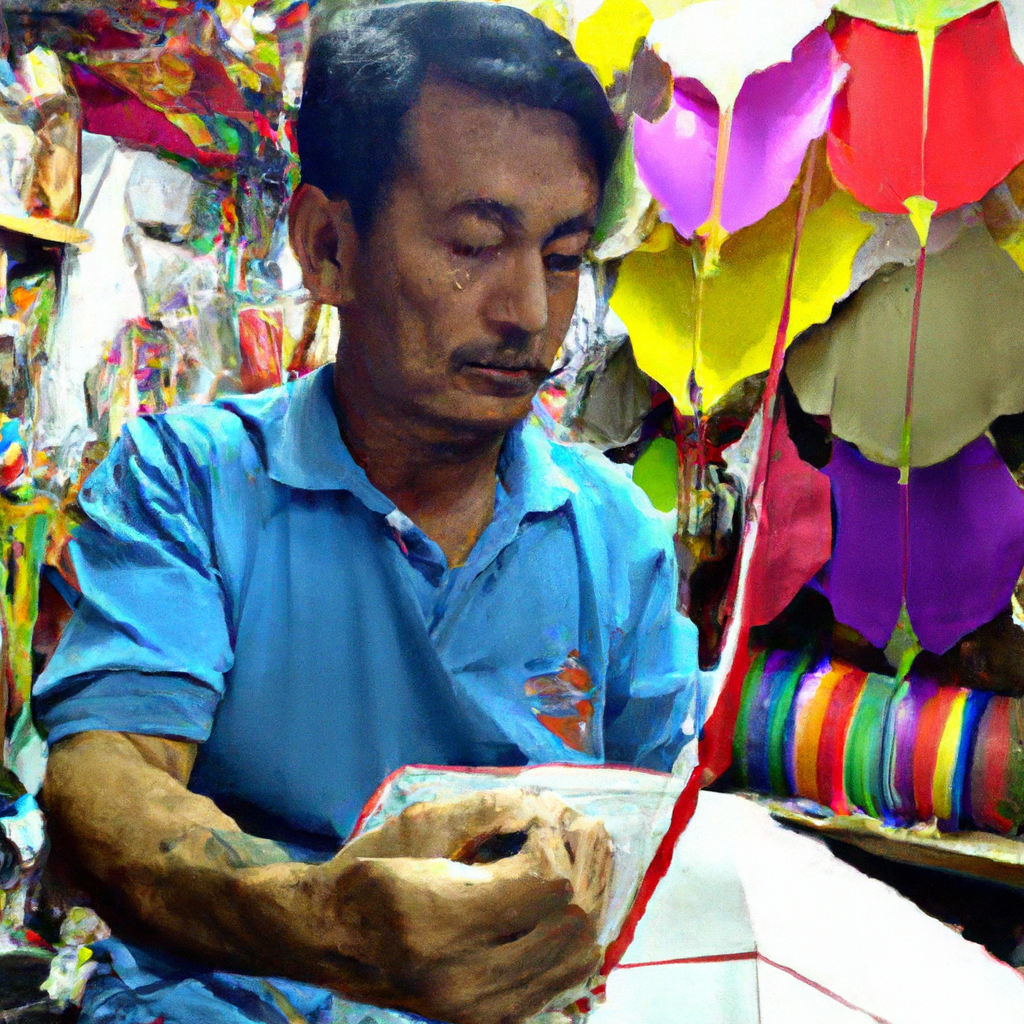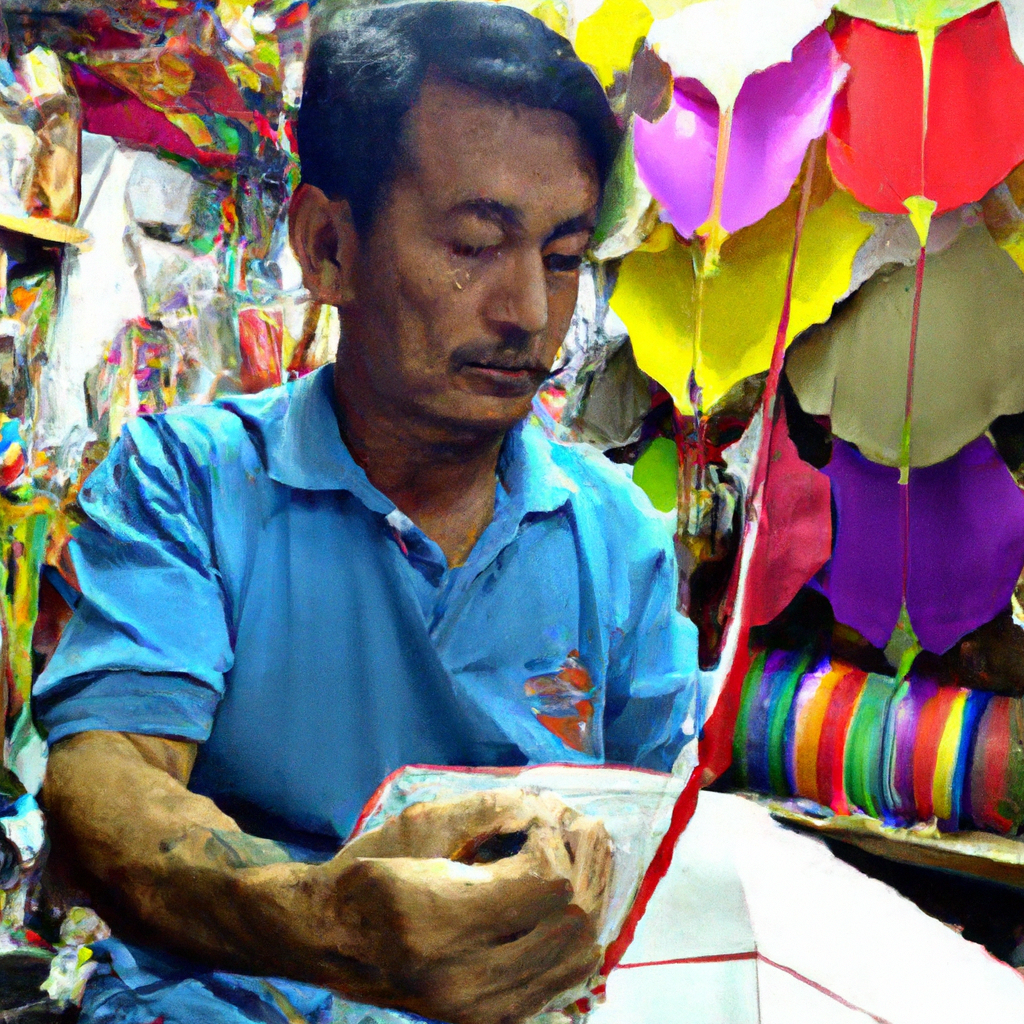Have you ever been intrigued by the rich cultural traditions of Thailand? One fascinating aspect of Thai heritage is the art of traditional kite making. It may surprise you to learn that kite making has a long and storied history in Thailand, dating back centuries. Through this craft, generations of Thai artisans have woven together their creativity, skill, and cultural heritage. Join us as we delve into the world of traditional Thai kite making, exploring its intricacies and the significance it holds in Thai culture.

The History of Kite Making
Origins of Kite Making in Thailand
Kite making holds a significant place in the rich cultural heritage of Thailand. The art of kite making in Thailand can be traced back to ancient times, where it is believed to have originated in China before spreading to neighboring countries, including Thailand. Thai kites, also known as “chula” in the local language, were initially used for religious purposes and as a means of communication.
Traditional Techniques Passed Down Through Generations
The art of Thai kite making has been passed down through generations, preserving traditional techniques and ensuring its continuity. This knowledge and expertise are typically handed down within families or among master artisans who have dedicated their lives to the craft. The intricate techniques involved in constructing and decorating kites have been carefully preserved and upheld, showcasing the skill and creativity of the Thai people.
Variations in Thai Kite Designs and Styles
Thai kite designs encompass a diverse range of styles, each with its own unique characteristics and symbolism. The designs often depict animals, mythical creatures, and cultural symbols, reflecting the rich traditions and beliefs of Thai culture. From the intricate details of the decoration to the overall shape and structure of the kite, the variations in Thai kite designs exemplify the creativity and imagination of the Thai people.
Materials Used in Thai Kite Making
Bamboo: The Backbone of a Thai Kite
Bamboo serves as the backbone of a Thai kite, providing strength and flexibility to withstand the wind. The use of bamboo is deeply ingrained in Thai culture and has been a traditional choice for constructing kites due to its availability and durability. The bamboo frames are meticulously crafted, ensuring the kite remains sturdy while in flight.
Colorful Paper and Fabric for Aesthetic Appeal
Colorful paper and fabric are used to cover the bamboo frame, giving the kite its vibrant and eye-catching appearance. The choice of materials varies, ranging from handmade paper to brightly colored silk. The selection of colors and patterns is carefully considered to enhance the visual appeal of the kite and reflect the cultural significance associated with different colors.
Natural Glues and Adhesives for Assembly
Traditional Thai kite makers often use natural glues and adhesives, such as rice paste or tree sap, to assemble the various components of the kite. These natural glues not only provide a strong bond but also align with the eco-friendly practices that are highly valued in Thai culture. The use of natural materials further adds to the authenticity and charm of Thai kite making.
Tools and Equipment for Thai Kite Making
Traditional Tools Passed Down through Generations
Thai kite making relies on a range of traditional tools that have been passed down through generations. These tools include bamboo cutters, knives, awls, and files, all of which are carefully crafted and sharpened to ensure precise and intricate work. The expertise required to effectively utilize these tools is acquired through years of practice and apprenticeship under skilled craftsmen.
Modern Tools and Innovations
While traditional tools play a vital role in Thai kite making, modern tools and innovations are gradually being incorporated to streamline the process. Machinery and equipment such as laser cutters, digital design software, and specialized adhesive applicators have been introduced to enhance efficiency and precision. However, the balance between traditional craftsmanship and modern techniques is maintained to retain the essence of Thai kite making.
The Symbolism in Thai Kite Designs
Depicting Animals and Mythical Creatures
Thai kite designs often incorporate depictions of animals and mythical creatures, each possessing symbolic meaning. Dragons, elephants, and birds are commonly featured, symbolizing power, wisdom, and freedom, respectively. These intricate designs not only showcase the creativity and artistic skills of the Thai people but also reflect their close connection with nature and their beliefs in the spiritual world.
Representing Cultural and Spiritual Beliefs
Thai kite designs act as visual representations of the country’s cultural and spiritual beliefs. Many kites incorporate elements of Buddhism, such as lotus flowers or images of deities, to pay homage to the predominant religion in Thailand. Other designs may reflect local folklore or traditional ceremonies, offering a glimpse into the cultural tapestry of the Thai society.
Kite Designs for Special Occasions and Festivals
Thai kite making is deeply intertwined with special occasions and festivals throughout the year. Kites are tailored to suit the theme of each event, reflecting the joy and excitement associated with these celebrations. From the vibrant lantern festival of Loy Krathong to the lively New Year festivities, custom-designed kites take center stage, adding a touch of color and festivity to the skies.

The Significance of Thai Kite Making in Local Culture
Kites as Symbolic Gifts and Offerings
Thai kites hold symbolic significance beyond their visual appeal. They are often used as gifts and offerings during religious ceremonies and important milestones in a person’s life. The act of gifting a handmade kite is a gesture of goodwill and blessings, symbolizing prosperity and good fortune for the recipient. This cultural practice reinforces the value and importance of Thai kite making in local society.
Kite Flying as a Popular Recreational Activity
Kite flying has been a cherished recreational activity in Thailand for centuries. People of all ages, from children to adults, gather in open spaces to fly their kites, engaging in friendly competitions and enjoying the thrill of flying. The sky transforms into a canvas of color and movement as kites of various shapes and sizes soar gracefully above. This shared experience fosters community cohesion and promotes a sense of joy and togetherness.
Kite-Making Workshops and Festivals
In recent years, kite-making workshops and festivals have gained popularity, providing opportunities for people to learn about and engage in the art of Thai kite making. These events allow participants to create their own kites under the guidance of skilled artisans, fostering a deeper appreciation for the intricate craftsmanship involved. Kite-making festivals, held annually in various parts of Thailand, showcase the vibrant culture of kite making, attracting both locals and tourists alike.
Thai Kite Making Techniques
Frame Construction: Building the Skeleton of the Kite
The construction of a Thai kite begins with the frame. Skilled craftsmen carefully select and shape bamboo poles, interlacing them to form the skeleton of the kite. The frame is meticulously measured and adjusted to achieve the desired shape and dimensions, ensuring stability and aerodynamic performance.
Covering the Frame: Adding Paper or Fabric
Once the frame is complete, colorful paper or fabric is added to cover the bamboo structure. The covering material is carefully cut and shaped to fit the frame, with excess being trimmed away. The paper or fabric is then secured onto the frame using natural glues, ensuring a tight and seamless fit.
Decorating the Kite: Paint, Embroidery, and Appliqué
The final step in Thai kite making involves decorating the kite with intricate designs, patterns, and symbols. Skilled artisans employ various techniques such as painting, embroidery, and appliqué to bring the kite to life. Every stroke of the brush or stitch of embroidery is executed with precision and care, resulting in visually stunning kites that capture the essence of Thai artistry.
Maintaining and Flying Thai Kites
Pre-flight Preparations and Inspections
Before launching a Thai kite, proper preparations and inspections are crucial to ensure a safe and enjoyable experience. Checking the integrity of the frame, ensuring the covering material is securely attached, and examining the stability of the bridle are all essential steps. Wind conditions, including wind speed and direction, are carefully considered to determine the suitability of flying conditions.
Traditional Techniques for Launching and Maneuvering
Thai kite makers have developed traditional techniques for launching and maneuvering kites. Experts use their knowledge of wind patterns, kite dynamics, and skillful line management to achieve optimal flight performance. These techniques include the use of hand reels for line control and the delicate art of “dancing” the kite in the air, controlling its movements with precision and grace.
Safety Measures and Tips for Kite Flying
Safety is of paramount importance when flying Thai kites. Observing safety guidelines, such as maintaining a safe distance from power lines and avoiding crowded areas, is crucial to prevent accidents and ensure the safety of both the kite flyer and those around them. It is also essential to choose appropriate flying locations, considering factors such as open space and absence of obstacles.
The Future of Thai Kite Making
Challenges in Preserving Traditional Techniques
Preserving traditional Thai kite making techniques faces challenges in the modern era. The rapid pace of technological advancements and changing societal dynamics pose a threat to the continuation of traditional craftsmanship. Efforts must be made to document and pass down the knowledge and skills of Thai kite making to future generations, ensuring the preservation of this cultural heritage.
Incorporating Modern Technologies and Innovations
While preserving tradition is important, embracing modern technologies and innovations can help revitalize the art of Thai kite making. Introducing digital design tools, eco-friendly adhesives, and lightweight materials can enhance the efficiency and accessibility of kite making. Striking a balance between preserving tradition and embracing innovation is key to ensuring the sustainability and relevance of Thai kite making in the future.
Promoting Thai Kite Making as a Cultural Heritage
Raising awareness and promoting Thai kite making as a cultural heritage is essential to its continued appreciation and recognition. Collaborating with educational institutions, cultural organizations, and tourism agencies can help highlight the significance of Thai kite making, both locally and internationally. Exhibitions, workshops, and public demonstrations can serve as platforms to showcase the beauty and significance of this traditional art form.
Famous Thai Kite Makers
Master Artisans and Their Contributions
Thai kite making has been shaped by the mastery and contributions of various talented artisans. Master craftsmen like Boonraksa Poonpun have dedicated their lives to preserving and advancing the art of Thai kite making. Their expertise and innovation have elevated the craft to new heights, inspiring future generations of kite makers.
Recognition and Awards for Thai Kite Makers
The exceptional talent and craftsmanship of Thai kite makers have not gone unnoticed. Several master craftsmen have received recognition and prestigious awards for their contributions to the art form. These accolades not only bring attention to the individual artisans but also shine a spotlight on Thai kite making as a significant cultural heritage.
Profiles of Renowned Thai Kite Makers
Renowned Thai kite makers each have their own unique style and expertise. Artists like Somprasong Songkloy and Kwanchai Khamsroi are known for their intricate designs and attention to detail. Their kites have been exhibited internationally, showcasing the excellence and creativity of Thai kite making to a global audience.
Thai Kites and Tourism
Kite Shops and Markets in Tourist Areas
Thai kites have become popular souvenirs among tourists visiting Thailand. Kite shops and markets located in tourist areas offer a wide variety of kites for purchase, ranging from traditional designs to modern adaptations. These establishments not only cater to tourists but also contribute to the local economy while keeping the ancient art form alive.
Kite Festivals as Popular Tourist Attractions
Kite festivals in Thailand have emerged as popular tourist attractions, drawing visitors from around the world. Festivals such as the Chula and Patang Festival in Bangkok and the International Kite Festival in Hua Hin attract kite enthusiasts, cultural enthusiasts, and curious travelers alike. These vibrant events showcase the vibrant colors and captivating performances of Thai kite making, leaving a lasting impression on tourists.
Incorporating Kite Making in Cultural Tours
Cultural tours in Thailand have begun incorporating kite-making experiences, allowing tourists to engage with the art form firsthand. Travelers can participate in workshops led by skilled artisans, learning about the techniques and symbolism behind Thai kite making. This immersive experience provides a deeper understanding of Thai culture and fosters an appreciation for the craftsmanship involved in creating these intricate kites.
In conclusion, the art of Thai kite making captivates with its rich history, intricate techniques, and vibrant designs. Preserving traditional Thai kite making techniques while embracing modern technologies is crucial to ensuring its continuity and relevance in the future. The significance of Thai kite making in local culture extends beyond its visual appeal, serving as symbolic gifts, a popular recreational activity, and a cultural heritage to be celebrated. With recognition and support, Thai kite making has the potential to thrive and continue captivating people for generations to come.
